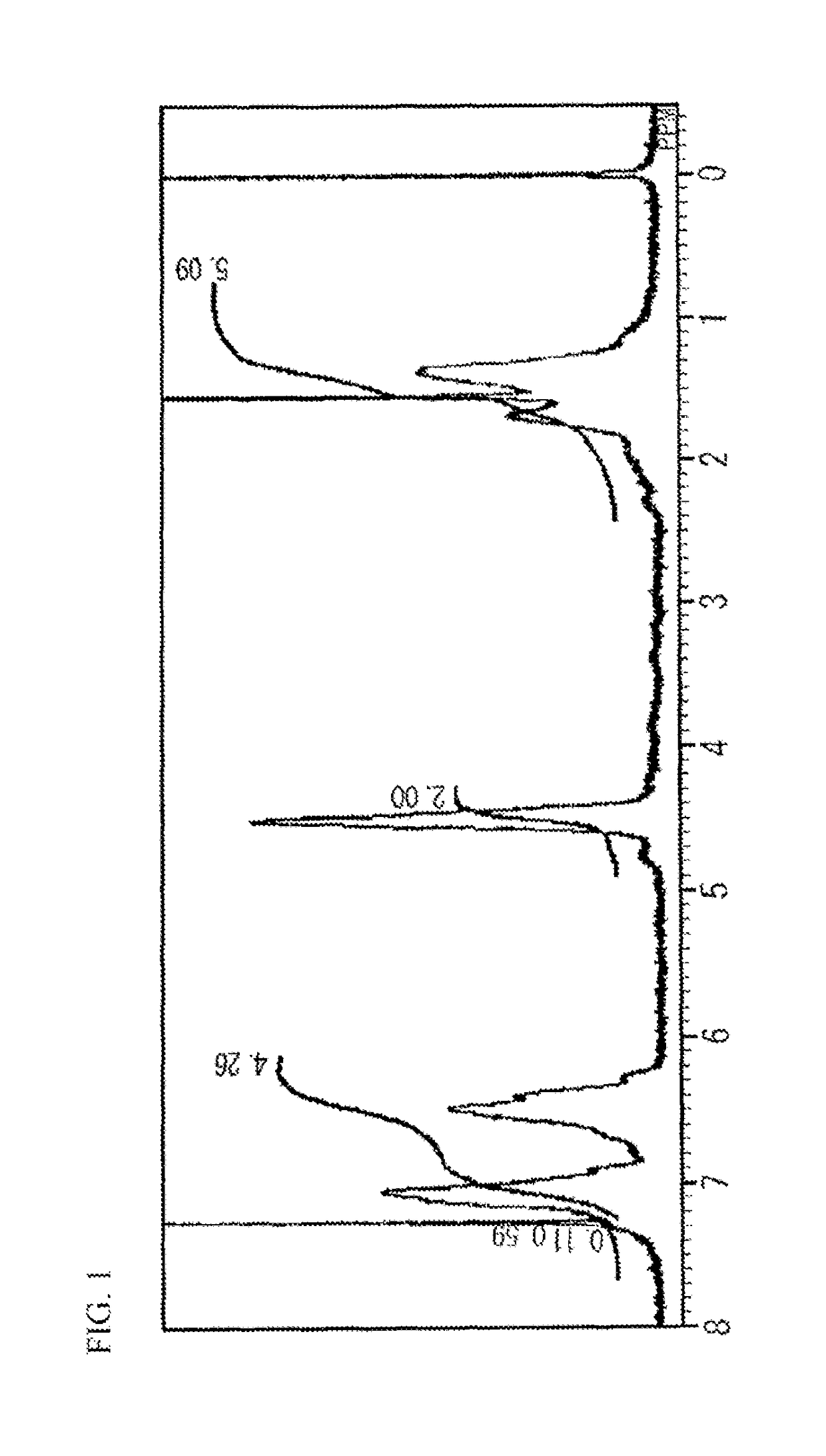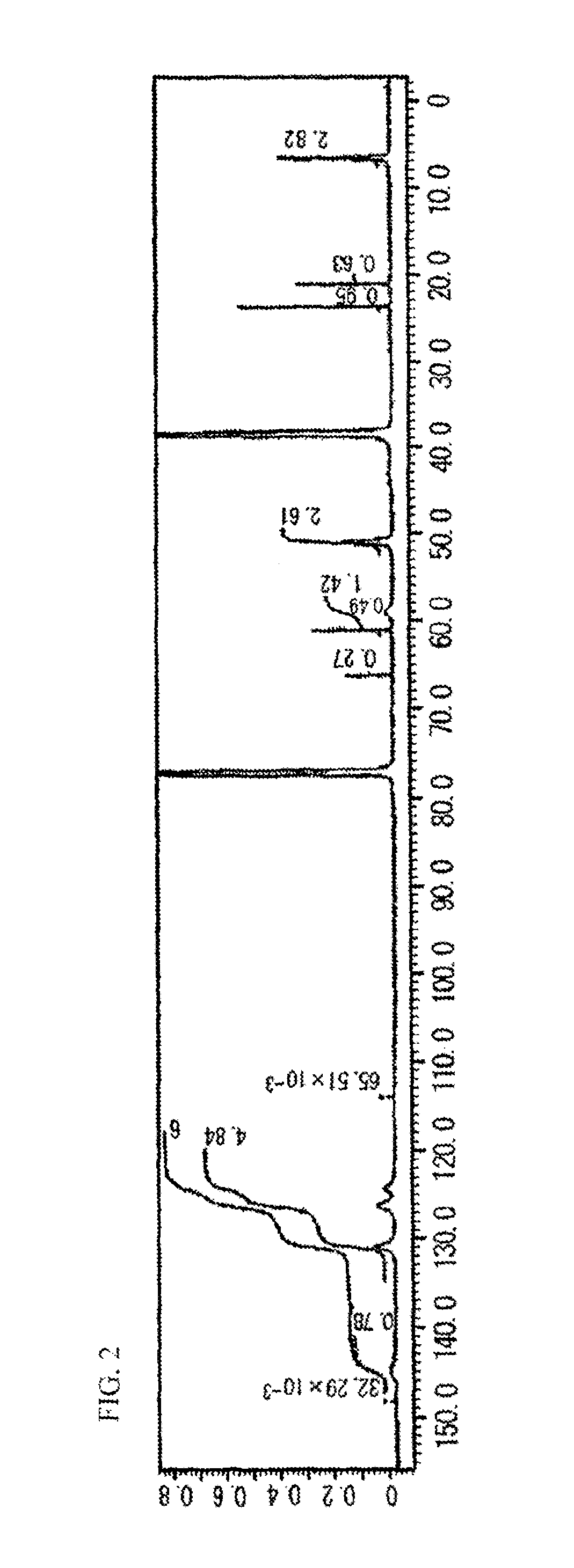Metal fine particle association and method for producing the same
a technology of metal fine particles and association, which is applied in the direction of electrochemical generators, cell components, transportation and packaging, etc., can solve the problems of clogging of active sites, achieve excellent catalyst activity, suppress the sintering of metal fine particles, and suppress the loss of activity due to the formation of aggregates
- Summary
- Abstract
- Description
- Claims
- Application Information
AI Technical Summary
Benefits of technology
Problems solved by technology
Method used
Image
Examples
synthesis example 1
Production of Chlorinated Hyperbranched Polymer (HPS-Cl)
[0188]
[0189]In a 500-mL reaction flask, 27 g of sulfuryl chloride [manufactured by KISHIDA CHEMICAL Co., Ltd.] and 50 g of chloroform were charged and stirred to be uniformly dissolved. This solution was cooled to 0° C. under a nitrogen gas flow.
[0190]In another 300-mL reaction flask, 15 g of hyperbranched polystyrene HPS having a dithiocarbamate group at a molecular end and 150 g of chloroform were charged and stirred to be homogenized under a nitrogen gas flow.
[0191]The solution was added from the 300-mL reaction flask containing the HPS / chloroform solution into the sulfuryl chloride / chloroform solution cooled to 0° C., using a transfer pump under a nitrogen gas flow over 60 minutes to attain reaction liquid temperatures of −5° C. to 5° C. After completion of the addition, the reaction liquid was stirred for six hours with the temperatures held at −5° C. to 5° C.
[0192]A solution of 16 g of cyclohexene [manufactured by Tokyo C...
synthesis example 2
Production of Hyperbranched Polymer 1 (HPS-NEt3Cl)
[0194]
[0195]In a 50-mL reaction flask with a reflux tower, 3.0 g (20 mmol) of HPS-Cl produced in Synthesis Example 1, 2.0 g (20 mmol) of triethylamine [manufactured by JUNSEI CHEMICAL CO., LTD.], and 30 mL of a chloroform / IPA liquid mixture (volumetric ratio 2:1) were charged, followed by replacement by nitrogen. This mixture was heated to reflux with stirring for 48 hours.
[0196]After cooling to a liquid temperature of 30° C., the solvent was distilled off. The resultant residue was dissolved into 50 mL of chloroform, and this solution was added to mL of IPE for reprecipitation and purification. The precipitated polymer was filtered under reduced pressure and vacuum-dried at 40° C., resulting in 6.1 g of a hyperbranched polymer 1 (hereinafter abbreviated as HBP1) having a triethylammonium group at a molecular end in the form of pale brown powder.
[0197]The 13C NMR spectrum of the resultant HBP1 is shown in FIG. 2. Based on the peaks o...
synthesis example 3
Production of Hyperbranched Polymer 2 (HPS-NBu3Cl)
[0198]
[0199]In a 50-mL reaction flask with a reflux tower, 3.0 g (20 mmol) of HPS-Cl produced in Synthesis Example 1, 3.7 g (20 mmol) of tributylamine [manufactured by JUNSEI CHEMICAL CO., LTD.], and 60 g of a chloroform / IPA liquid mixture (volumetric ratio 2:1) were charged, followed by replacement by nitrogen. This mixture was heated to reflux with stirring for 48 hours.
[0200]After cooling to a liquid temperature of 30° C., the solvent was distilled off. The resultant residue was dissolved into 50 mL of chloroform, and this solution was added to mL of IPE for reprecipitation and purification. The precipitated polymer was filtered under reduced pressure and vacuum-dried at 40° C., resulting in 5.8 g of a hyperbranched polymer 2 (hereinafter abbreviated as HBP2) having a tributylammonium group at a molecular end in the form of pale brown powder.
[0201]The 13C NMR spectrum of the resultant HBP2 is shown in FIG. 3. Based on the peaks of...
PUM
| Property | Measurement | Unit |
|---|---|---|
| mean particle diameter | aaaaa | aaaaa |
| particle size | aaaaa | aaaaa |
| length size | aaaaa | aaaaa |
Abstract
Description
Claims
Application Information
 Login to View More
Login to View More - R&D
- Intellectual Property
- Life Sciences
- Materials
- Tech Scout
- Unparalleled Data Quality
- Higher Quality Content
- 60% Fewer Hallucinations
Browse by: Latest US Patents, China's latest patents, Technical Efficacy Thesaurus, Application Domain, Technology Topic, Popular Technical Reports.
© 2025 PatSnap. All rights reserved.Legal|Privacy policy|Modern Slavery Act Transparency Statement|Sitemap|About US| Contact US: help@patsnap.com



